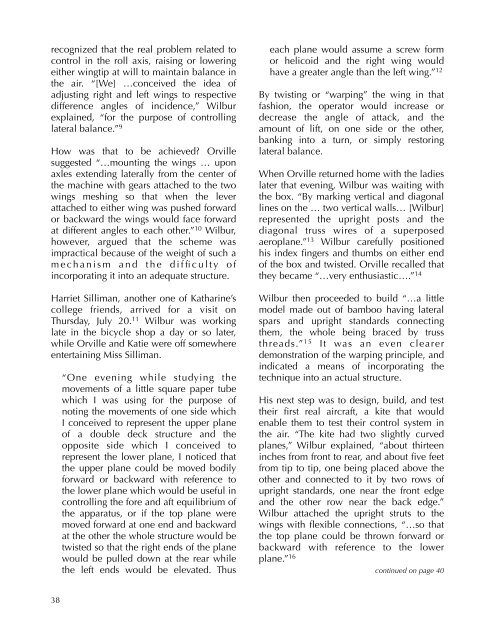You also want an ePaper? Increase the reach of your titles
YUMPU automatically turns print PDFs into web optimized ePapers that Google loves.
ecognized that the real problem related to<br />
control in the roll axis, raising or lowering<br />
either wingtip at will to maintain balance in<br />
the air. “[We] …conceived the idea of<br />
adjusting right and left wings to respective<br />
difference angles of incidence,” Wilbur<br />
explained, “for the purpose of controlling<br />
lateral balance.” 9<br />
How was that to be achieved? Orville<br />
suggested “…mounting the wings … upon<br />
axles extending laterally from the center of<br />
the machine with gears attached to the two<br />
wings meshing so that when the lever<br />
attached to either wing was pushed forward<br />
or backward the wings would face forward<br />
at different angles to each other.” 10 Wilbur,<br />
however, argued that the scheme was<br />
impractical because of the weight of such a<br />
m e c h a n i s m a n d t h e d i f fi c u l t y o f<br />
incorporating it into an adequate structure.<br />
Harriet Silliman, another one of Katharine’s<br />
college friends, arrived for a visit on<br />
Thursday, July 20. 11 Wilbur was working<br />
late in the bicycle shop a day or so later,<br />
while Orville and Katie were off somewhere<br />
entertaining Miss Silliman.<br />
“One evening while studying the<br />
movements of a little square paper tube<br />
which I was using for the purpose of<br />
noting the movements of one side which<br />
I conceived to represent the upper plane<br />
of a double deck structure and the<br />
opposite side which I conceived to<br />
represent the lower plane, I noticed that<br />
the upper plane could be moved bodily<br />
forward or backward with reference to<br />
the lower plane which would be useful in<br />
controlling the fore and aft equilibrium of<br />
the apparatus, or if the top plane were<br />
moved forward at one end and backward<br />
at the other the whole structure would be<br />
twisted so that the right ends of the plane<br />
would be pulled down at the rear while<br />
the left ends would be elevated. Thus<br />
each plane would assume a screw form<br />
or helicoid and the right wing would<br />
have a greater angle than the left wing.” 12<br />
By twisting or “warping” the wing in that<br />
fashion, the operator would increase or<br />
decrease the angle of attack, and the<br />
amount of lift, on one side or the other,<br />
banking into a turn, or simply restoring<br />
lateral balance.<br />
When Orville returned home with the ladies<br />
later that evening, Wilbur was waiting with<br />
the box. “By marking vertical and diagonal<br />
lines on the … two vertical walls… [Wilbur]<br />
represented the upright posts and the<br />
diagonal truss wires of a superposed<br />
aeroplane.” 13 Wilbur carefully positioned<br />
his index fingers and thumbs on either end<br />
of the box and twisted. Orville recalled that<br />
they became “…very enthusiastic….” 14<br />
Wilbur then proceeded to build “…a little<br />
model made out of bamboo having lateral<br />
spars and upright standards connecting<br />
them, the whole being braced by truss<br />
threads.” 15 It was an even clearer<br />
demonstration of the warping principle, and<br />
indicated a means of incorporating the<br />
technique into an actual structure.<br />
His next step was to design, build, and test<br />
their first real aircraft, a kite that would<br />
enable them to test their control system in<br />
the air. “The kite had two slightly curved<br />
planes,” Wilbur explained, “about thirteen<br />
inches from front to rear, and about five feet<br />
from tip to tip, one being placed above the<br />
other and connected to it by two rows of<br />
upright standards, one near the front edge<br />
and the other row near the back edge.”<br />
Wilbur attached the upright struts to the<br />
wings with flexible connections, “…so that<br />
the top plane could be thrown forward or<br />
backward with reference to the lower<br />
plane.” 16 continued on page 40<br />
38


